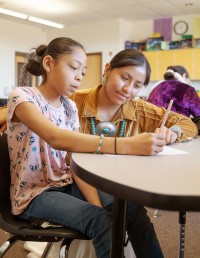After Review of 2020 Pandemic Spending Plans, Education Advocates Call for More Transparency, Accountability, & Services as Some $55B in Federal & State Funds Flow to K12
FOR IMMEDIATE RELEASE
May 18, 2021
Contact: Patty Guinto, [email protected]
San Francisco, CA – Several prominent education advocacy organizations released a report today sounding an urgent alarm over the need for increased transparency and public accountability mechanisms in the spending of some $55B in one-time and on-going state and federal funds available to California to spur the recovery of public schools across the state. In 20 recommendations, they also call for increased stakeholder engagement, more services to students with unique needs, re-engagement strategies, consideration of staff allocation and the integration of new practices and technology use into learning, and more.
The report, co-authored by Children Now, Public Advocates, the National Center for Youth Law and Californians Together presents findings from a review of 48 Learning Continuity & Attendance Plans (LCPs), which were required of school districts, county offices of education and charter schools (Local Education Agencies, LEAs) in the fall of 2020 during the height of the pandemic. The report is titled “How Districts Planned for Pandemic Learning: Equity-Driven Practices and Lessons Learned from 2020 Learning Continuity and Attendance Plans.”
In the report, the organizations urge school districts to learn from their 2020 experiences as they plan for unprecedented amounts of federal and state investments in education.
”This is a once in a generation opportunity to reimagine our schools with transformative investments that can ensure all students will thrive,” said Erin Apte, Legislative Counsel with Public Advocates. “We cannot repeat past mistakes from 2020-21, when districts did not publicly account for billions of dollars in federal and state pandemic relief funds. This left stakeholders, who under the law must be partners in planning, in the dark about how these funds were spent,” added Apte.
School districts across the state are currently developing their Local Control and Accountability Plans (known as LCAPs) to address the pressing needs of California’s 6 million students, some returning to school sites this fall for the first time in more than a year. Many returning students are low-income, English learners, foster youth, and students with disabilities, who are homeless, or incarcerated.
“We reviewed these plans and budgets to get a snapshot of how districts were willing to support some of our most underserved students in California,” said Atasi Uppal, Senior Policy Attorney at the National Center for Youth Law. “We were very concerned to find almost a complete lack of information regarding how districts were going to help youth in the juvenile justice system and youth experiencing homelessness access pandemic-related needs such as stable internet, mental health services and supportive reengagement strategies for those disconnected from school. Districts must make intentional, intensive investments to support these young people during the upcoming school year; they need tailored interventions and services more than ever before.”
The authors of the report identified both promising practices in the 48 LCPs that other districts could emulate, as well as concerning trends, particularly regarding investments and omissions of important information that districts were required to report. For example, most of the plans the authors reviewed did a poor job of clearly showing how LEAs invested the more than $8 billion in pandemic relief they received, in addition to billions in ongoing state funding, including Supplemental and Concentration (“S&C”) funds generated by students in foster care, students in low-income families, and English learners (“high-need students”).
“Students in foster care face so many challenges that can disrupt learning and the pandemic has further exacerbated the situation,” said Danielle Wondra, Senior Policy and Outreach Associate, Child Welfare, for Children Now. “It is imperative that LEAs provide greater details in their plans about the supports they will provide to students in foster care, describe how these services address the specific challenges these students face, and meaningfully consider how the supports they provide are differentiated to meet the unique needs of students in foster care. If they don’t, students in foster care will continue to fall further and further behind,” added Wondra.
Noting that the pandemic is not yet behind us, the authors of the report make a series of recommendations concerning what LEAs should prioritize now as they create their legally-required local spending plans and millions of California students move to in-person learning. They focus on more accountability to ensure funds are spent effectively and the integration of critical services such as mental health promotion, social-emotional learning, peer support, and trauma-informed practices into school and classroom environments.





